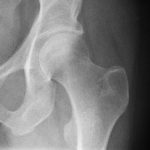Diagnosis: Achilles Tendon Rupture
Presentation:
An Achilles tendon rupture is an injury located at the back of the leg and the heel. This injury commonly occurs during a sport whilst stopping and starting to run again at a rapid pace. The patient will present with sharp pain immediately after a pop or snap has occurred. After this, it is very common that the patient will not be able to walk or will experience significant pain whilst attempting to do so. There will be swelling around the heel and back of the lower leg, and it is common for the patient to have significant difficulty when contracting their calf muscle (Brukner & Khan, 2012).
An Achilles tendon rupture is an injury located at the back of the leg and the heel. #performbetter @pogophysio Share on XDiagnosis:
A very accurate diagnosis is often reached without the use of radiography. The physiotherapist will have good evidence for diagnosis after the patient interview, where they are particularly looking to hear if a snap or pop was involved. The physiotherapist will perform what is called the “Thompson Test“, which involves squeezing the back of the leg at the calf and observing the integrity of the Achilles tendon and other structures. Muscle testing of the calf can also aid in the diagnosis if the Thompson Test had unclear results. Radiography can be used if there is still confusion, it is most useful to determine if there is a need for surgery (Brukner & Khan, 2012).
Causes:
The Achilles tendon can become quite weak with age or rest from a particular activity. The Achilles tendon is the most common tendon to rupture as it very stretchy. People who have had previous conditions that weaken the tendon will be more susceptible to rupture, these conditions include: Achilles tendonitis and more minor Achilles strains. Rupture normally occurs during sport or exercises, example in a game of soccer where the player tries to take off in a burst, planting the foot back and exerting maximum stretch and force through the tendon. Other sports where this can occur are: basketball, tennis, rugby and at the start of a running race. The injury can also occur outside of a sporting scenario when stepping backwards from a small height or stepping in a hole (Hess, Gregory, & William, 2016).
Treatment:
For Achilles tendon ruptures, conservative, non-surgical management has been shown to be very effective for full return to function. Patients will wear a Controlled Ankle Motion boot until the tendon has healed. Once they are out of the boot, strengthening exercises are used to strengthen the entire leg and the non-affected leg as all muscles will have some wastage after this period of rest. Manual therapy will also be used to restore full movement at the ankle as it becomes very stiff from wearing the Boot. If conservative management does not work or the rupture is deemed too large, the Achilles tendon will have to be surgically reattached. After this surgery, a Controlled Ankle Motion Boot is also used and conservative Physiotherapy is commenced (Kocher, Bishop, Marshall, Briggs, & Hawkins, 2002).
Daniel O’Connor
Student Physiotherapist
References
Brukner, P. & Khan, K. (2012). Brukner & Khan’s clinical sports medicine (pp. 797-800). Sydney: McGraw-Hill.
Hess, Gregory, & William,. (2016). Achilles Tendon Rupture. Foot & Ankle Specialist, 3(1), 29-32.
Kocher, M., Bishop, J., Marshall, R., Briggs, K., & Hawkins, R. (2002). Operative versus nonoperative management of acute Achilles tendon rupture: expected-value decision analysis. The American Journal Of Sports Medicine, 30(6), 783.









